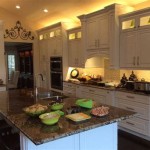Kitchen Cabinet Refinishing Paint: Essential Aspects for a Successful Transformation
Kitchen cabinet refinishing is a cost-effective and transformative way to update the look and feel of your kitchen without the expense of a complete remodel. Choosing the right paint is crucial for a successful and durable refinishing project. Here are the essential aspects to consider when selecting kitchen cabinet refinishing paint:
1. Type of Cabinet Paint:
There are two main types of kitchen cabinet paint: latex and oil-based. Latex paint is water-based, dries quickly, and has low odor. It's easy to clean up and offers a wide range of colors and finishes. Oil-based paint is more durable and provides a smoother finish, but it takes longer to dry and has a stronger odor. Consider the specific needs of your project and the desired finish before selecting a type of paint.
2. Paint Sheen:
The sheen of paint refers to its level of shine. For kitchen cabinets, satin or eggshell finishes are popular choices. Satin has a slightly reflective surface, while eggshell is more matte. Both finishes are durable and easy to clean, making them suitable for kitchen environments. High-gloss finishes are more reflective but can show blemishes more easily.
3. Coating Type:
Some kitchen cabinet paints are specifically designed with additional coatings to enhance durability. These coatings can provide resistance to moisture, heat, and wear and tear. Look for paints that offer protective coatings, such as polyurethane or enamel finishes, to ensure longevity.
4. Color and Colorants:
Choose a paint color that complements the style and decor of your kitchen. Consider the natural light in the room and the desired ambiance. Custom colorants can be added to create unique and personalized shades. It's recommended to test the paint color on a small area of the cabinet before committing to an entire refinishing project.
5. Primer:
A primer is essential for creating a strong bond between the paint and the cabinet surface. It helps cover stains, prevent bleed-through, and ensure a professional-looking finish. Choose a primer specifically designed for kitchen cabinets, as they are often formulated with additional properties for durability and adhesion.
6. Preparation:
Proper preparation is crucial before applying paint. Clean the cabinets thoroughly to remove dirt, grease, and any hardware. Sand the surface to smooth out any imperfections and ensure the paint adheres properly. Use painter's tape to protect any areas you don't want to paint, such as countertops or backsplash.
7. Application:
Follow the manufacturer's instructions for proper paint application. Use a brush or roller designed for kitchen cabinets. Apply thin, even coats, and allow each coat to dry completely before applying the next. Sand lightly between coats to create a smooth and professional finish.
By considering these essential aspects of kitchen cabinet refinishing paint, you can achieve a durable and aesthetically pleasing transformation that will refresh the look of your kitchen for years to come.

Cabinet Refacing Vs Painting Which Is Right For You

Kitchen Cabinet Refinishing Guide How We Got A Durable Chip Free Finish

Cabinet Refinishing Guide

The Pros And Cons Of Kitchen Cabinet Painting Refinishing Mastercraft Finishes

A Step By Guide To Painting Kitchen Cabinets With Kilz Primer Blog

Cabinet Refinishing An 8 Step Guide For Pro Painters Ppc

9 Step Guide To Diy Kitchen Cabinet Refinishing

Kitchen Cabinet Painting Vs Replacement Which Has The Best Roi

Refinishing Kitchen Cabinets Repaint Or Restrain Your Cupboards

How To Paint Kitchen Cabinets Without Sanding Or Priming
Related Posts








